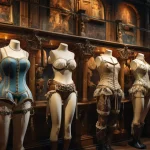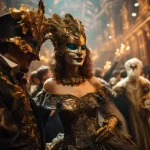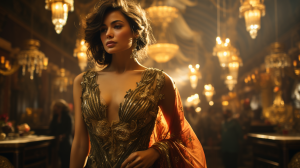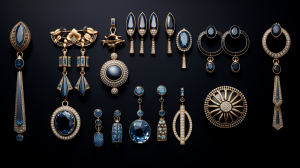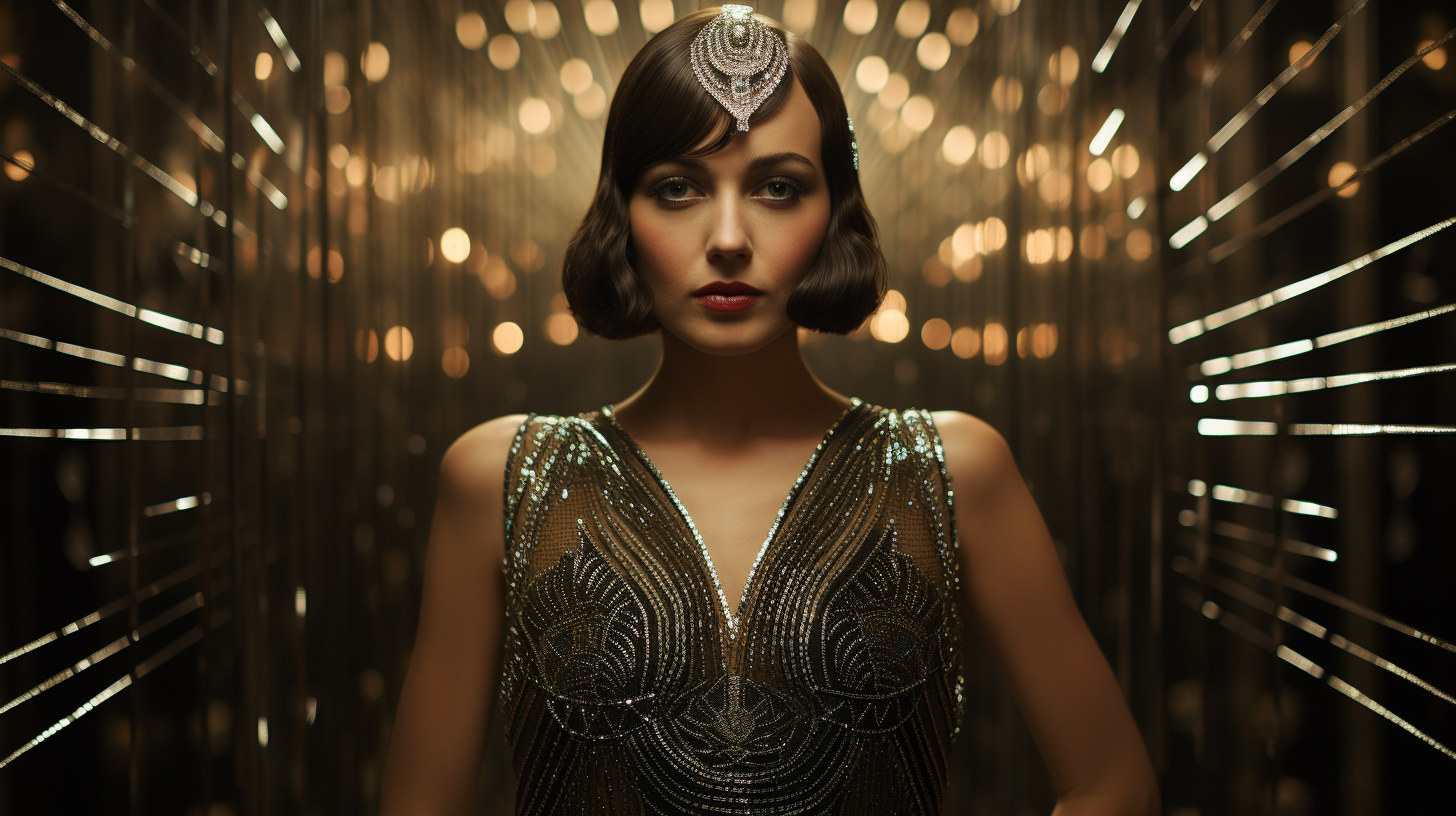
Glamour and Elegance: Exploring the Art Deco Fashion Era
Embark on a voyage through the resplendent realm of Art Deco’s fashion heritage, where each step is a stride in a grand ballroom of elegance and luxurious charm. We shall delve into the heart of the 1920s and 1930s, an epoch steeped in unprecedented extravagance, characterized by audacious geometric patterns, meticulous attention to detail, and an indomitable flair for the elegant and the avant-garde. This deep dive will navigate the myriad facets of Art Deco’s fashion legacy, from its sumptuous fabric choices and trademark silhouettes to the cultural currents that molded it and the significant part the silver screen played in disseminating its captivating allure.
Let us submerge ourselves in the epoch that exulted in lavishness and grace, a time when fashion transcended mere attire, becoming an emblem of the prevailing ethos. The Art Deco period witnessed fashion’s emancipation, as it adopted a novel aesthetic brimming with luxury and contemporaneity. Together, we shall probe all these dimensions and beyond in our odyssey across the Art Deco fashion landscape.
The Roaring Twenties: A Fashion Revolution
The Roaring Twenties was a time of metamorphosis, a post-war epoch of rediscovery, reverberating through the annals of fashion. Art Deco fashion burgeoned, mirroring the Jazz Age’s vitality and the transformation in women’s fashion. Garments took a daring turn, becoming more ornate and emblematic of the shifting societal mores. It was a time when fashion became a means of articulation, with women’s attire shedding the yoke of past conventions.
Central to this era was the iconic flapper dress, epitomizing societal upheaval and autonomy. With its relaxed fit and simplistic cut, it signaled a rebellion against prior sartorial constraints, accentuating lower waistlines, succinct hemlines, and providing the wearer with unprecedented mobility. Embellishments like beads and sequins lent a sprinkle of glamour, anchoring the flapper dress as a symbol of the Jazz Age and burgeoning female emancipation.
Moreover, the 1920s heralded seminal fashion movements reflective of the global socio-cultural and economic shifts. Women, now a more pronounced workforce presence, sought practical yet stylish apparel, giving rise to the ‘garçonne look,’ marked by abbreviated hair, loosely tailored attire, and an overall unisex vibe. This fashion transformation was not merely a fad but a potent social commentary on women’s evolving societal role.
Art Deco’s Opulent Textiles
The masterpieces of Art Deco fashion were painted upon the canvases of opulent textiles. Silk, velvet, and metallic threads were lavishly employed, endowing Art Deco apparel with a rich, glamorous halo. Chosen for their inherent sheen and sumptuousness, these materials contributed to the clothing’s luster, its body-caressing drape, and the light-catching dynamism during movement.
The quintessence of luxury textile utilization in Art Deco fashion is epitomized in the creation of evening gowns. Crafted from silk or velvet, these dresses radiated an air of nobility and sophistication, while metallic fabrics like lamé or brocade imparted a regal, glittering opulence. Beadwork and sequins frequently adorned these textiles, amplifying their splendor and capturing every onlooker’s gaze.
The commitment to artisanal skill also significantly elevated Art Deco’s luxurious fashion narrative. Beading and embroidery artistry was meticulously applied to conjure complex designs, with embellishments serving not only an aesthetic function but also symbolizing the wearer’s affluence and status. This focus on detail and craftsmanship further enhanced the sumptuous Art Deco aesthetic.
The Iconic Art Deco Silhouettes
Art Deco fashion introduced an array of seminal silhouettes, revolutionizing fashion’s panorama. The flapper dress’s linear, liberated structure starkly contrasted with the previously coveted hourglass figure. These silhouettes were not just stylistic; they mirrored the social shifts and burgeoning women empowerment.
Discussing Art Deco’s silhouettes necessitates homage to the bias-cut gown. With its sinuous lines and sensual allure, it gained prominence in the Art Deco age. The bias-cut gown caressed the body’s contours, offering an elegant and complimentary figure. This cutting method allowed fabric to gracefully cling to and flow around the body.
Moreover, accessories like headbands, elongated necklaces, and feather boas became significant, not merely as adjuncts but as essential elements of the Art Deco ensemble, injecting glamour and refinement into the overall presentation.
Cultural Catalysts in Art Deco’s Aesthetic
Art Deco fashion was not an isolated phenomenon but a product of its age, sculpted by the technological, global, and artistic influences of its time. It heralded the Machine Age with designs featuring sleek lines and geometric motifs, while the allure of world cultures was evident in design inspirations derived from ancient civilizations.
For instance,
the discovery of Tutankhamun’s tomb in 1922 instigated an Egyptian revival, with motifs like the scarab and lotus flower percolating into fashion designs. Orientalism also influenced Art Deco, with designers drawing inspiration from the Far East’s exoticism, integrating features like kimono-style sleeves and Chinese embroidery.
The Silver Screen’s Influence
The silver screen was a crucial conduit for Art Deco fashion, with Hollywood’s golden era stars donning and popularizing this distinctive style. Cinema offered a platform for Art Deco fashion to be showcased, glamorized, and ultimately adopted by the masses.
Greta Garbo, Marlene Dietrich, and other silver screen sirens were often spotted in Art Deco styles, setting the fashion trends for their era. Their on-screen attire significantly influenced public fashion choices, demonstrating the intertwined relationship between film and fashion during the Art Deco period.
A Legacy Etched in Elegance
In the soft light of a bygone era, Art Deco fashion emerged as more than mere threads and weaves. It was a declaration, an expression of culture woven into every seam and stitch. It stood proud as a herald of change, a beacon of luxury and unbridled glamour in a time of transformation.
Today, like an old melody that hums through the ages, Art Deco continues to weave its influence through the tapestries of modern style, echoing its affinity for grandeur and elegance.
Our journey today is but a gentle skim across the vast, opulent ocean that is Art Deco’s legacy in fashion. Its enduring impact, the subtle complexities of its history, they still dance through the hearts and minds of those who cherish fashion’s past, inspiring creators and dreamers to this very day.



